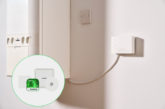
SD Plumbing & Heating looks at how smart controls can help your customers to save money and future-proof their systems.
Smart heating controls are expected to play a key part in preparing houses for the future; more and more we’re having discussions with clients about the benefits of smart controls for their homes.
Smart controls are attracting an increasing number of homeowners, who are attracted to the intuitive features and cost-saving benefits that many of them provide – especially now that everyone’s heating bills are going up.
A lot of people are still unsure about anything with “smart” in the name, but hopefully after reading this you can be in a better position to sell it on your clients.
It’s an opportunity for you to generate new business because practically every smart heating control gadget recommends or specifies expert installation. With a better understanding or the benefits, you can be in a much better position to sell them.
So, what are the advantages of smart heating control gadgets and how can you tell your costumers about them? Here are some of the key features to market the technology to your customers.
User-friendliness
One of the most obvious advantages that smart control installers may tell their consumers is their simplicity of use, whether it’s making it easier to set and manage heating schedules via an app or having the capacity to regulate the temperature of their house remotely.
This ease of use can be further strengthened by using voice control systems like Google Assistant and Amazon Alexa, which are becoming increasingly popular among customers as a way to manage appliances in their homes.
There are a variety of heating controls on the market currently that can communicate with these devices effortlessly and that installers can recommend.
Savings on energy
Installers can not only help their clients improve their comfort levels, but they can also help them improve the energy efficiency of their homes and lower their energy bills by recommending the installation of smart controls.
According to new research from the University of Salford, replacing a regular room thermostat and programmer with a smart heating control saves 6% of energy while replacing a Class I room thermostat with a Class V or VI thermostat saves another 12%.
Some thermostats, such as Wiser, can adapt heating schedules to changing weather conditions and include an ‘away mode’ that allows users to turn off the heating without having to change the schedule. When engaged, these two smart modes can assist cut energy consumption by 7% and 24% respectively.
Installers can help their customers save even more money by installing a smart control with multi-zoning capability. According to the University of Salford, zoning can lower energy use by 19%.
Renewable energy-friendly
More homes are replacing their boilers with alternative heat sources, such as heat pumps, thanks to government funds to stimulate the installation of renewable heat sources.
It’s critical for installers working on these projects to choose the proper heating control in conjunction with the renewable heat source to guarantee that the client enjoys the same degree of comfort as the gas heating system being replaced.
A heating control should support the OpenTherm protocol to optimally modulate the heat pump for maximum performance. Many smart heating controls do, and it allows clients to gain information about how their renewable heat source is functioning.
Prepared to face the future
Home Energy Management Systems (HEMS), which provide a single user interface or app for controlling all connected devices in the home, are expected to play a bigger role in predicting future energy demand for household applications.
HEMS may be able to assist homeowners to save money on their energy bills in addition to improving the home’s energy efficiency by understanding the homeowner’s habits.
Heating experts are in a unique position to future-proof today’s homes while also providing their customers with a more efficient heating system.
Assurance of simple and speedy installation
Control upgrades are quick and easy with a simple smart thermostat that is wireless and incorporates an industry-standard backplate, with installations taking as little as 10 minutes, meaning a quick job for you and cheaper prices for the homeowner.
Control of the Time Proportional Integral (TPI)
TPI, or Time Proportional Integral Control, is the godfather of this technology, automatically recognising how the environment around it responds and adapting accordingly, without the need for intervention or set up, as has been the case in recent months.
TPI is used in advanced and sophisticated heating controls. This ensures that the customer’s boiler fires for the least amount of time possible to achieve and maintain the required temperature. It adds to the energy efficiency of the system, saving an additional 13% over a basic set of heating controls.
The Geo-fencing feature
Geo-fencing, a feature in the software that employs the global positioning system (GPS) or Radio Frequency Identification (RFID) to designate geographical locations, is the most recent technology.
In thermostat terms, this means that smart controls may now enable remote control of the boiler by turning the heating on or off based on the homeowner’s location.
As a result of the app, the control can determine how far the homeowner is from home and adjust the heating in time for their arrival, or turn it down to frost protection level when they depart.
Isn’t it clever? What’s more, all of these ‘layers’ are hidden behind a sophisticated back-end, yet the control itself is simple to use for any age of consumer with a smartphone.
OpenTherm technology
Then there’s OpenTherm technology, which improves the thermostat-to-boiler communication even more.
By lowering the flow temperature as it leaves the boiler, OpenTherm allows the quantity of heat provided by the boiler to be adjusted to match the shifting demand signal.
By running at lower flow temperatures for extended periods, this modulation improves boiler efficiency. Installers can now offer this additional layer of ‘smart’ to clients as more OpenTherm certified boilers become available on the UK market.
Conclusion
The future of household heating controls is smart, linked thermostats. They provide more comfort and energy savings than traditional counterparts.
Technology is in every part of our lives in today’s culture, including the employment of smart technology in the house. Why should homeowners’ central heating systems be any different?
They use smart apps to control everything from their kettles to their TVs and refrigerators, so why should their central heating systems be any different? The answer is that they shouldn’t, and it’s up to an installer to explain why.













